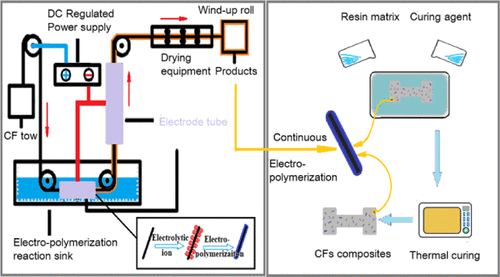当前位置:
X-MOL 学术
›
ACS Appl. Polym. Mater.
›
论文详情
Our official English website, www.x-mol.net, welcomes your
feedback! (Note: you will need to create a separate account there.)
Surface Modification of Carbon Fiber by Electro-Polymerization: Continuous Production, Thickness Control, Colorization, and Preparation of CFRP
ACS Applied Polymer Materials ( IF 4.4 ) Pub Date : 2020-06-17 , DOI: 10.1021/acsapm.0c00232 Bincheng Zhao 1, 2 , Hui Gao 1, 2 , Sanbao Li 3 , Jun Nie 1, 4 , Fang Sun 1, 2 , Xiaoqun Zhu 1, 4
ACS Applied Polymer Materials ( IF 4.4 ) Pub Date : 2020-06-17 , DOI: 10.1021/acsapm.0c00232 Bincheng Zhao 1, 2 , Hui Gao 1, 2 , Sanbao Li 3 , Jun Nie 1, 4 , Fang Sun 1, 2 , Xiaoqun Zhu 1, 4
Affiliation

|
Carbon fibers (CFs) have been widely used as reinforcing materials because of their excellent specific strength, specific modulus, corrosion resistance, energy absorption, and other properties. To improve the mechanical properties of CF-reinforced composites, one of the effective methods is to improve the interfacial force between the CF and the polymer through modification of CFs. The aim of this study is to modify the surface of the CF with an environmentally friendly and efficient way and to design a continuous production equipment. In this research, a continuous electro-polymerization equipment was designed, and the surface of the CFs was modified by epoxy or vinyl ether, which was initiated by photoinitiator UVI-6974 without adding any solvent and extra electrolytes. By changing the structure of monomers, polymerization time, voltage, concentration of the initiator, and the distance between CFs and electrodes, the performance and thickness of the polymer layer on the CFs were controllable. The results of scanning electron microscopy and infrared spectroscopy proved that the surface of the CFs was covered by polymers, and some unreacted functional groups remained. The mechanical performances of CF composites prepared from the BDE/DVE-3-modified CFs showed that the interlaminar shear strength improved by 46.98 and 62.02%, and the tensile strength improved by 11.40 and 16.62%, respectively, compared with unmodified CFs. This proved that the interface force between the resin and the CF was greatly improved by the thin polymer layer on the surface of the CF and the unreacted functional groups. On the other hand, if pigments or dyes were added to the polymerization system, colored CFs could be fabricated by this equipment continuously. Because of the solvent-free, low-voltage, and continuous fabrication, this electro-polymerization method has a good industrial prospect.
中文翻译:

电聚合对碳纤维的表面改性:连续生产,厚度控制,着色和CFRP制备
碳纤维(CFs)由于其出色的比强度,比模量,耐蚀性,能量吸收和其他特性而被广泛用作增强材料。为了改善CF增强复合材料的机械性能,一种有效的方法是通过改性CF来改善CF与聚合物之间的界面力。这项研究的目的是通过一种环保,高效的方法来修饰CF的表面,并设计出一种连续的生产设备。在这项研究中,设计了一种连续的电聚合设备,并且用环氧或乙烯基醚对CF的表面进行了改性,而环氧或乙烯基醚则是由光引发剂UVI-6974引发的,没有添加任何溶剂和额外的电解质。通过改变单体的结构,聚合时间,电压,引发剂的浓度,CF和电极之间的距离,CF上聚合物层的性能和厚度是可控制的。扫描电子显微镜和红外光谱的结果证明,CFs的表面被聚合物覆盖,并且残留了一些未反应的官能团。由BDE / DVE-3-改性的CFs制备的CF复合材料的力学性能表明,与未改性的CFs相比,层间剪切强度分别提高了46.98%和62.02%,拉伸强度分别提高了11.40%和16.62%。这证明通过CF表面上的聚合物薄层和未反应的官能团大大改善了树脂和CF之间的界面力。另一方面,如果将颜料或染料添加到聚合系统中,该设备可以连续制造彩色CF。由于无溶剂,低压,连续制造,这种电聚合方法具有良好的工业前景。
更新日期:2020-07-10
中文翻译:

电聚合对碳纤维的表面改性:连续生产,厚度控制,着色和CFRP制备
碳纤维(CFs)由于其出色的比强度,比模量,耐蚀性,能量吸收和其他特性而被广泛用作增强材料。为了改善CF增强复合材料的机械性能,一种有效的方法是通过改性CF来改善CF与聚合物之间的界面力。这项研究的目的是通过一种环保,高效的方法来修饰CF的表面,并设计出一种连续的生产设备。在这项研究中,设计了一种连续的电聚合设备,并且用环氧或乙烯基醚对CF的表面进行了改性,而环氧或乙烯基醚则是由光引发剂UVI-6974引发的,没有添加任何溶剂和额外的电解质。通过改变单体的结构,聚合时间,电压,引发剂的浓度,CF和电极之间的距离,CF上聚合物层的性能和厚度是可控制的。扫描电子显微镜和红外光谱的结果证明,CFs的表面被聚合物覆盖,并且残留了一些未反应的官能团。由BDE / DVE-3-改性的CFs制备的CF复合材料的力学性能表明,与未改性的CFs相比,层间剪切强度分别提高了46.98%和62.02%,拉伸强度分别提高了11.40%和16.62%。这证明通过CF表面上的聚合物薄层和未反应的官能团大大改善了树脂和CF之间的界面力。另一方面,如果将颜料或染料添加到聚合系统中,该设备可以连续制造彩色CF。由于无溶剂,低压,连续制造,这种电聚合方法具有良好的工业前景。









































 京公网安备 11010802027423号
京公网安备 11010802027423号